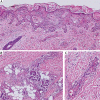Daily follow-up of a scary onset of ecchymotic purpuric lesions in an infant
- PMID: 36090732
- PMCID: PMC9454372
- DOI: 10.5114/ada.2022.118925
Daily follow-up of a scary onset of ecchymotic purpuric lesions in an infant
Conflict of interest statement
The authors declare no conflict of interest.
Figures


Similar articles
-
[Acute hemorrhagic edema of infancy].Pan Afr Med J. 2019 Jul 12;33:191. doi: 10.11604/pamj.2019.33.191.16154. eCollection 2019. Pan Afr Med J. 2019. PMID: 31692802 Free PMC article. French.
-
Acute hemorrhagic edema of infancy: a report of two cases.Indian J Dermatol Venereol Leprol. 2012 Jan-Feb;78(1):121. doi: 10.4103/0378-6323.90969. Indian J Dermatol Venereol Leprol. 2012. PMID: 22199081
-
[Acute hemorrhagic edema of infancy].Pan Afr Med J. 2019 Jul 29;33:267. doi: 10.11604/pamj.2019.33.267.16184. eCollection 2019. Pan Afr Med J. 2019. PMID: 31692796 Free PMC article. French.
-
The rash that becomes purpuric, petechial, hemorrhagic, or ecchymotic.Clin Dermatol. 2020 Jan-Feb;38(1):3-18. doi: 10.1016/j.clindermatol.2019.07.036. Epub 2019 Aug 1. Clin Dermatol. 2020. PMID: 32197746 Review.
-
The 'sparing phenomenon' of purpuric rash over tattooed skin.Dermatology. 2014;228(1):27-30. doi: 10.1159/000356779. Epub 2013 Dec 14. Dermatology. 2014. PMID: 24356492 Review.
References
-
- Snow IM. Purpura, urticaria and angioneurotic edema of the hands and feet in a nursing baby. JAMA 1913; 61: 18-9.
-
- Carder KR. Hypersensitivity reactions in neonates and infants. Dermatol Ther 2005; 18: 160-75. - PubMed
LinkOut - more resources
Full Text Sources
